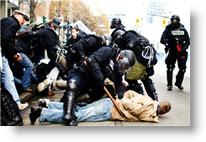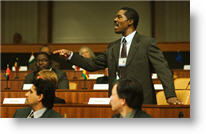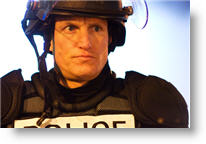Battle in Seattle
 for language and some violence.
for language and some violence.
Reviewed by: Kenneth R. Morefield
CONTRIBUTOR
| Moral Rating: | Offensive |
| Moviemaking Quality: |
|
| Primary Audience: | Adults Young-Adults |
| Genre: | Action Political Drama |
| Length: | 1 hr. 40 min. |
| Year of Release: | 2008 |
| USA Release: |
September 19, 2008 DVD: March 10, 2009 |
| Featuring |
|---|
|
Charlize Theron Woody Harrelson Ray Liotta Ivana Milicevic Michelle Rodriguez Channing Tatum Jennifer Carpenter Rade Serbedzija Connie Nielsen See all » |
| Director |
|
Stuart Townsend |
| Producer |
|
Mary Aloe Ashok Amritraj See all » |
| Distributor |
| ThinkFilm |
“The whole world is watching.”
“Battle in Seattle” is a profoundly cynical movie masquerading as an idealistic one—or, maybe, it is a profoundly idealistic one that simply doesn’t know how cynical it is.
The film is a docudrama depicting protest activity in response to a scheduled meeting of the World Trade Organization (WTO). Charlize Theron stars as the pregnant wife of a police officer (Woody Harrelson). Her character, I suspect, is supposed to be the neutral center of the film, residing in a political and social space somewhere between her misguided, but well-meaning, law-and-order husband on one side, and the well-meaning, but perhaps too zealous, liberal activists on the other.
If you have any doubts about where the filmmakers lie on this spectrum, keep a close watch to see who beats Theron’s character in the stomach causing her to lose her baby. The protesters may be the remote cause of violence by unleashing chaos that spirals out of control, but all the real damage to innocents is perpetrated by the borderline fascist defenders of corporate interests. Towards the end of the film, two protesters (or terrorists, depending on your point of view) discuss what they and their partners (or co-conspirators) have accomplished through their non-violence demonstrations (or riots). The week before, one opines, nobody knew what the WTO was. And now, as a result of their actions? “They still don’t know, but they know it’s bad.”
A major problem with this sort of cynicism is that it is not just directed towards its subject; it is also directed towards its audience. After all, if the audience can’t be trusted to understand the arguments underlying the protests, how can it be trusted to understand the arguments underlying a film about the protests? Or is the film winking at the audience, suggesting that its members, like the protesters, know better, but simply can’t be bothered to try to convince the great hordes of conformists who must be freed like so many denizens of Plato’s cave from prisons they don’t even understand that they are in? I don’t necessarily disagree with the film’s opinion of the WTO or the effects of multi-industrial globalization; it’s just that when one side of any argument claims to be above having to explain itself, I start to feel like I’m hearing propaganda rather than persuasion.
“Battle in Seattle” begins on the eve of a meeting of the World Trade Organization meeting. The protesters are already in place, so we get next to no procedural information about how or (more importantly) why, they are protesting. Motives that are revealed throughout the film are personal, rather than political. I would like to think the filmmakers were trying to capture a bit of the spirit of “And the Band Played On”—highlighting the setting over any individual character in order to give us a sense of how widespread were the ripples of the phenomenon it was documenting. I suspect, however, that the unwillingness to get too close to any one participant was the film’s concession to what Charles Krauthammer once labeled “moral exhaustion.” The increasing frequency of demands on the modern person to make moral judgments about politics, rather than creating a vital exchange of ideas has led to a sort of spiritual weariness and, Krauthammer argues, a retreat to “moral equivalence.”
There is a lot of moral equivalence floating around in “Battle in Seattle.” So much, in fact, that it acts as flotsam, fogging the waters until we can’t see clearly what point the film is trying to make. The protesters aren’t criminals; they are passionate citizens who want to save the world. But the police aren’t wrong, either. They are dedicated family men who are just trying to make the streets safe for their pregnant wives. The villains are big corporations and big government but—this is an important distinction—not the individuals that represent them or comprise them. These are actually conflicted people who would do right if they could.
“Battle in Seattle” echoes “Crash” in one way—the seriousness of its subject gives it a sheen that will make some people think it is more complex and daring than it really is. Instead of an exploration of the effects of international commerce, we get lots of shots of crowds chanting and tear gas being sprayed that are pretty generic and tend to merge in our consciousness into every shot of a chanting crowd we’ve ever seen on the evening news. The whole point of such movies is supposed to be that the three minute segment on the evening news is insufficient to probe important subjects, isn’t it? So why does “Battle in Seattle” seem so much in substance (if not length) like an evening news segment? Visuals are privileged over ideas; it’s more important to show people protesting than to convey what they are protesting about. There is a scrupulous, almost Manichean duality that masquerades as objectivity; first there is a sound bite from one side, then a sound bite from another side. There is even a fake resolution to mask the fact that no attempt has been made to address (much less answer) the root issues prompting the protest.
For all that, the film is sincere, and there are some who will praise it (if not like it) for being well-minded if not well-made. Indeed, I feel a bit cranky to have picked on it so much. If the film’s glossy emptiness irritates me rather than simply leaving me indifferent, perhaps it is because I believe there are films that can and do deal with complex contemporary issues without pandering or condescending: “Dead Man Walking,” “Why We Fight,” “No End in Sight,” “Enron: The Smartest Guys in the Room,” “Life + Debt,” and “A Promise to the Dead” are all examples of such films. Books like Deep Economy, The World is Flat, Blink, and The Tipping Point explore social and global connections without giving in to moral exhaustion.
In the end, “Battle in Seattle” bit off more than it could chew. It is about too important a subject to be treated as a movie of the week and about conflicts too far reaching to be resolved through the narrative release from prison of one surrogate protester. As of the writing of this review, the film had not yet been rated in the United States but was rated PG in Canada for its release at the Toronto International Film Festival, primarily for depictions of street violence.
Violence: Moderate / Profanity: Mild / Sex/Nudity: Minor













My Ratings: Moral rating: Average / Moviemaking quality: 2